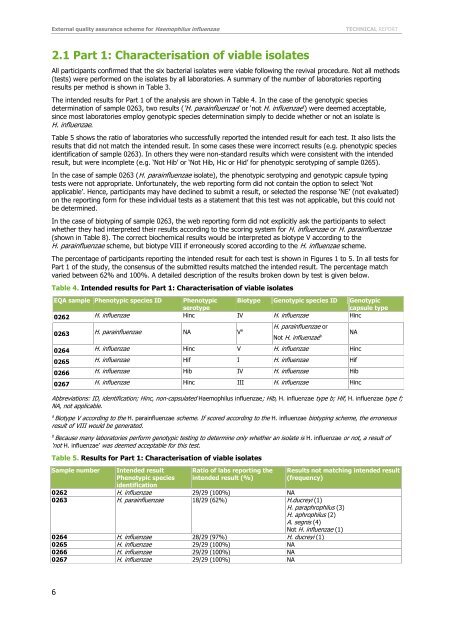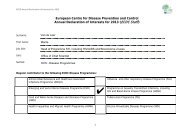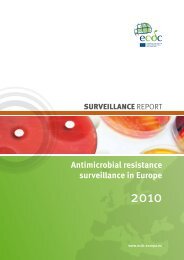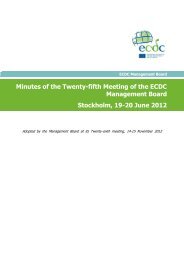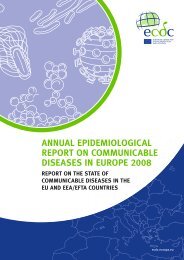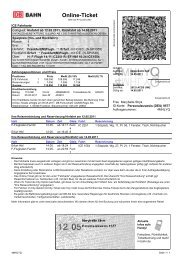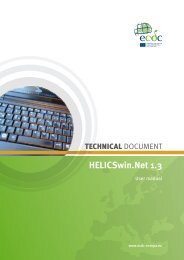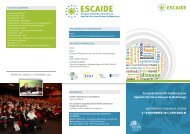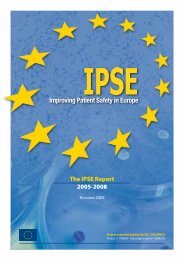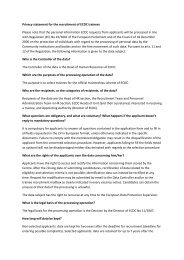External quality assurance scheme for Haemophilus influenzae 2011
External quality assurance scheme for Haemophilus influenzae 2011
External quality assurance scheme for Haemophilus influenzae 2011
Create successful ePaper yourself
Turn your PDF publications into a flip-book with our unique Google optimized e-Paper software.
<strong>External</strong> <strong>quality</strong> <strong>assurance</strong> <strong>scheme</strong> <strong>for</strong> <strong>Haemophilus</strong> <strong>influenzae</strong><br />
TECHNICAL REPORT<br />
2.1 Part 1: Characterisation of viable isolates<br />
All participants confirmed that the six bacterial isolates were viable following the revival procedure. Not all methods<br />
(tests) were per<strong>for</strong>med on the isolates by all laboratories. A summary of the number of laboratories reporting<br />
results per method is shown in Table 3.<br />
The intended results <strong>for</strong> Part 1 of the analysis are shown in Table 4. In the case of the genotypic species<br />
determination of sample 0263, two results (‘H. para<strong>influenzae</strong>’ or ‘not H. <strong>influenzae</strong>’) were deemed acceptable,<br />
since most laboratories employ genotypic species determination simply to decide whether or not an isolate is<br />
H. <strong>influenzae</strong>.<br />
Table 5 shows the ratio of laboratories who successfully reported the intended result <strong>for</strong> each test. It also lists the<br />
results that did not match the intended result. In some cases these were incorrect results (e.g. phenotypic species<br />
identification of sample 0263). In others they were non-standard results which were consistent with the intended<br />
result, but were incomplete (e.g. ‘Not Hib’ or ‘Not Hib, Hic or Hid’ <strong>for</strong> phenotypic serotyping of sample 0265).<br />
In the case of sample 0263 (H. para<strong>influenzae</strong> isolate), the phenotypic serotyping and genotypic capsule typing<br />
tests were not appropriate. Un<strong>for</strong>tunately, the web reporting <strong>for</strong>m did not contain the option to select ‘Not<br />
applicable’. Hence, participants may have declined to submit a result, or selected the response ‘NE’ (not evaluated)<br />
on the reporting <strong>for</strong>m <strong>for</strong> these individual tests as a statement that this test was not applicable, but this could not<br />
be determined.<br />
In the case of biotyping of sample 0263, the web reporting <strong>for</strong>m did not explicitly ask the participants to select<br />
whether they had interpreted their results according to the scoring system <strong>for</strong> H. <strong>influenzae</strong> or H. para<strong>influenzae</strong><br />
(shown in Table 8). The correct biochemical results would be interpreted as biotype V according to the<br />
H. para<strong>influenzae</strong> <strong>scheme</strong>, but biotype VIII if erroneously scored according to the H. <strong>influenzae</strong> <strong>scheme</strong>.<br />
The percentage of participants reporting the intended result <strong>for</strong> each test is shown in Figures 1 to 5. In all tests <strong>for</strong><br />
Part 1 of the study, the consensus of the submitted results matched the intended result. The percentage match<br />
varied between 62% and 100%. A detailed description of the results broken down by test is given below.<br />
Table 4. Intended results <strong>for</strong> Part 1: Characterisation of viable isolates<br />
EQA sample Phenotypic species ID Phenotypic<br />
serotype<br />
Biotype Genotypic species ID Genotypic<br />
capsule type<br />
0262 H. <strong>influenzae</strong> Hinc IV H. <strong>influenzae</strong> Hinc<br />
0263 H. para<strong>influenzae</strong> NA V a H. para<strong>influenzae</strong> or<br />
Not H. <strong>influenzae</strong> b<br />
0264 H. <strong>influenzae</strong> Hinc V H. <strong>influenzae</strong> Hinc<br />
0265 H. <strong>influenzae</strong> Hif I H. <strong>influenzae</strong> Hif<br />
0266 H. <strong>influenzae</strong> Hib IV H. <strong>influenzae</strong> Hib<br />
0267 H. <strong>influenzae</strong> Hinc III H. <strong>influenzae</strong> Hinc<br />
Abbreviations: ID, identification; Hinc, non-capsulated <strong>Haemophilus</strong> <strong>influenzae</strong>; Hib, H. <strong>influenzae</strong> type b; Hif, H. <strong>influenzae</strong> type f;<br />
NA, not applicable.<br />
a<br />
Biotype V according to the H. para<strong>influenzae</strong> <strong>scheme</strong>. If scored according to the H. <strong>influenzae</strong> biotyping <strong>scheme</strong>, the erroneous<br />
result of VIII would be generated.<br />
b<br />
Because many laboratories per<strong>for</strong>m genotypic testing to determine only whether an isolate is H. <strong>influenzae</strong> or not, a result of<br />
‘not H. <strong>influenzae</strong>’ was deemed acceptable <strong>for</strong> this test.<br />
Table 5. Results <strong>for</strong> Part 1: Characterisation of viable isolates<br />
Sample number<br />
Intended result<br />
Phenotypic species<br />
identification<br />
Ratio of labs reporting the<br />
intended result (%)<br />
NA<br />
Results not matching intended result<br />
(frequency)<br />
0262 H. <strong>influenzae</strong> 29/29 (100%) NA<br />
0263 H. para<strong>influenzae</strong> 18/29 (62%) H.ducreyi (1)<br />
H. paraphrophilus (3)<br />
H. aphrophilus (2)<br />
A. segnis (4)<br />
Not H. <strong>influenzae</strong> (1)<br />
0264 H. <strong>influenzae</strong> 28/29 (97%) H. ducreyi (1)<br />
0265 H. <strong>influenzae</strong> 29/29 (100%) NA<br />
0266 H. <strong>influenzae</strong> 29/29 (100%) NA<br />
0267 H. <strong>influenzae</strong> 29/29 (100%) NA<br />
6


